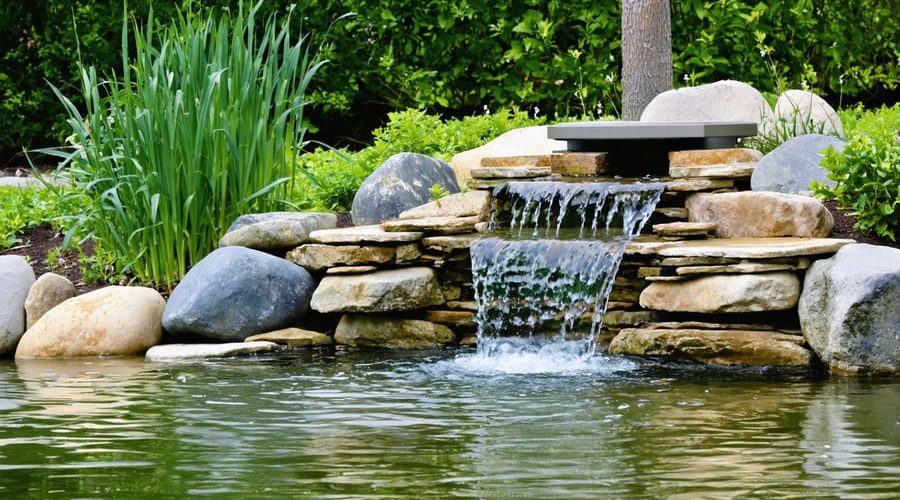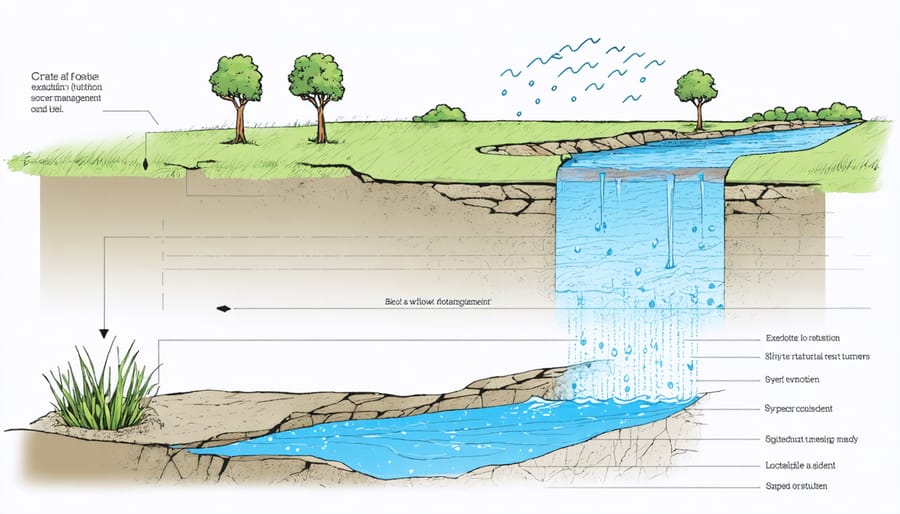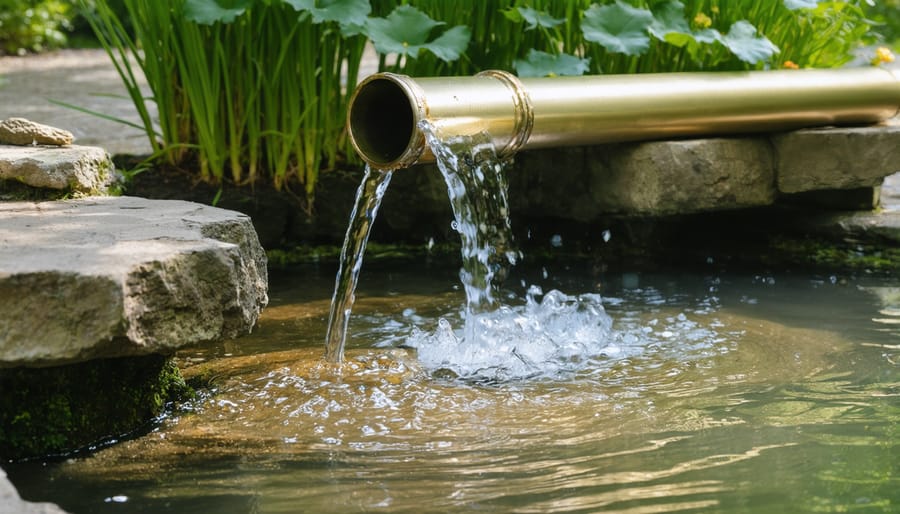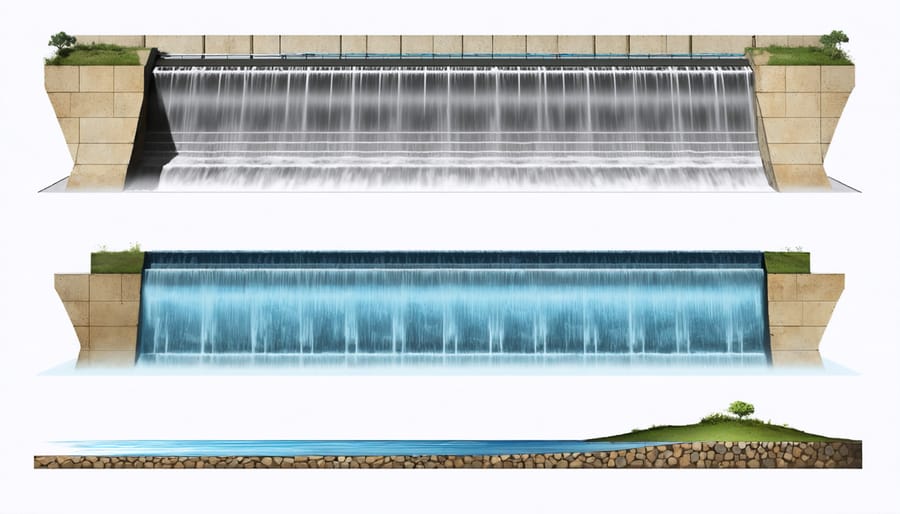
Protect Your Pond: Smart Overflow Solutions That Actually Work
A well-designed pond overflow structure stands as the crucial safeguard between a thriving water feature and potential disaster. Acting like your pond’s safety valve, these essential systems prevent flooding during heavy rains, protect surrounding landscapes, and maintain optimal water levels for aquatic life. Whether you’re building a new pond or upgrading an existing one, understanding overflow structures isn’t just about preventing problems – it’s about ensuring your water garden’s long-term success. From simple standpipes to more sophisticated spillways, these systems work silently yet effectively to protect your investment while adding both functional and aesthetic value to your outdoor space. For pond owners and DIY enthusiasts alike, mastering the basics of overflow structures opens up a world of possibilities for creating more resilient and beautiful water features that can withstand whatever nature throws their way.
Why Your Pond Needs an Overflow Structure

Common Pond Overflow Problems
Pond overflow problems can quickly turn your peaceful water feature into a headache if not properly addressed. The most common issue is erosion around the overflow area, where rushing water can wash away soil and damage landscaping. This not only looks unsightly but can also compromise the structural integrity of your pond.
Flooding is another significant concern, especially during heavy rainfall. Without adequate overflow capacity, excess water can spill into unwanted areas, potentially damaging your garden or, worse, your home’s foundation. Many pond owners also face the challenge of maintaining water quality when overflow occurs, as rapid water movement can stir up sediment and debris.
Algae buildup around overflow structures is particularly troublesome, as it can clog the system and reduce its effectiveness. During storms, overflow problems can lead to fish loss if the structure isn’t properly screened. Regular maintenance and proper design are essential to preventing these common issues and ensuring your pond remains a source of enjoyment rather than stress.
Benefits of Proper Overflow Management
Proper overflow management brings multiple benefits to your pond ecosystem and landscape. By maintaining consistent water levels, you protect your pond’s edges from erosion and prevent flooding during heavy rains. This stability is crucial for aquatic plants that thrive in specific water depths and helps maintain the natural balance of your pond environment.
A well-designed overflow system acts as a safety net for your fish population. It prevents them from being swept away during storms while allowing excess water to escape smoothly. This is especially important for smaller fish and fry that might otherwise get caught in strong currents.
Your surrounding landscape also benefits from controlled overflow. Rather than having water spill randomly and create muddy patches, a proper structure directs excess water to designated areas. This helps preserve your garden design and prevents water damage to nearby structures or plantings. Additionally, managing overflow properly can create attractive water features like mini streams or waterfalls, adding visual interest to your pond area while serving a practical purpose.
Types of Pond Overflow Structures
Standpipe Systems
A standpipe system is one of the most popular and reliable methods for controlling pond water levels. This vertical pipe, typically made of PVC, stands upright in your pond and acts like a drain in a bathtub. When water rises above the pipe’s height, it simply flows down the pipe and out through your drainage system.
Installing a standpipe is relatively straightforward. The pipe is connected to a base that runs underground and away from your pond. You can easily adjust the water level by changing the height of the pipe. Many pond owners appreciate that standpipes are hidden below the water’s surface, maintaining the pond’s natural appearance.
For extra filtration, you can add a cage or screen around the pipe to prevent debris and fish from entering. This simple addition makes maintenance much easier and protects your pond’s inhabitants. Remember to check and clean your standpipe regularly to ensure it’s working properly, especially during rainy seasons.

Spillways
Spillways come in various forms and serve as essential safety features for ponds of all sizes. Natural spillways utilize existing landscape contours, often incorporating rocks and native plants to create a gentle water flow path that looks like it belongs in your garden. These can be as simple as a strategically placed channel lined with river rocks or as elaborate as a cascading stream.
Constructed spillways offer more control over water flow and typically include concrete or plastic structures. Popular options include weir spillways, which create a sheet-like water flow, and pipe spillways that direct excess water underground. For smaller garden ponds, pre-fabricated spillway units provide an easy-to-install solution that can be disguised with decorative rocks and plants.
When choosing a spillway, consider your pond’s size, local rainfall patterns, and aesthetic preferences. A well-designed spillway not only prevents flooding but can also become an attractive water feature, adding the peaceful sound of flowing water to your outdoor space. For the best results, ensure your spillway can handle your area’s heaviest typical rainfall while complementing your pond’s natural appearance.
Biological Filters with Overflow
Combining biological filtration with overflow structures creates an efficient dual-purpose system for your pond. These innovative pond filtration systems use gravity to process water through filter media while simultaneously managing excess water levels. The setup typically includes a skimmer box or waterfall filter positioned slightly above your desired pond level. As water rises, it flows through filter materials like bio-balls or filter mats, trapping debris and nurturing beneficial bacteria before safely exiting through the overflow pipe. This clever design saves space and reduces maintenance needs by integrating two essential functions into one unit. Many pond owners appreciate this solution because it maintains crystal-clear water while preventing flooding, making it an excellent choice for both small garden ponds and larger water features.
DIY Installation Tips
Planning Your Overflow System
When planning your overflow system, the first step is choosing the right location. Consider the natural slope of your land and identify the lowest point of your backyard pond design. This spot is typically ideal for your overflow structure, as it works with gravity to direct excess water away from your pond.
To calculate your pond’s overflow capacity needs, consider your local rainfall patterns and the surface area of your pond. A good rule of thumb is to plan for handling the volume of water from a heavy one-hour rainfall. For example, if your pond is 100 square feet and your area receives 1 inch of rain per hour during storms, your overflow system should handle about 62 gallons of water per hour.
Remember to direct overflow water away from your home’s foundation and avoid channeling it toward neighboring properties. Consider incorporating a rain garden or creating a natural-looking stream bed to manage the overflow while adding visual interest to your landscape. This approach not only handles excess water effectively but also enhances your overall garden design.

Installation Steps
Before starting installation, ensure you have all necessary tools and safety equipment, including gloves and safety glasses. Begin by determining the ideal location for your overflow structure – typically at the pond’s highest desired water level. Mark this spot clearly.
First, dig a trench leading away from the pond, maintaining a slight downward slope for proper drainage. The trench should be deep enough to accommodate your chosen overflow pipe, usually 3-4 inches in diameter.
Next, install the overflow inlet at your marked location. If using a skimmer box, secure it firmly to the pond liner using waterproof sealant and stainless-steel screws. For standpipe systems, cut a hole in the liner carefully, install a rubber grommet, and insert the pipe.
Connect your drainage pipe to the inlet structure, ensuring all joints are properly sealed. Test the connections by slowly filling the pond with water. Watch for any leaks around the seals and joints.
Finally, cover the drainage trench with gravel or create a decorative rock garden around the overflow area. This not only looks attractive but also helps prevent soil erosion around the structure. Remember to regularly check for debris accumulation around the inlet to maintain proper function.
Common Installation Mistakes
When installing a pond overflow structure, avoid setting it too high or too low – this is the most common mistake that can lead to flooding or dry pond edges. Don’t skip proper leveling, as even a slight tilt can cause uneven water distribution. Another frequent error is using improper pipe sizes; always match them to your pond’s volume and anticipated rainfall.
Watch out for loose connections and poor sealing around the overflow pipe, which can cause leaks and soil erosion. Many DIYers also forget to install a debris screen, leading to clogs and reduced efficiency. Finally, don’t position the overflow structure where discharged water could damage landscaping or create muddy areas. Take time to plan the water’s exit path and consider adding a small gravel bed to prevent soil erosion.
Maintenance and Troubleshooting
Seasonal Maintenance Tasks
Keeping your pond overflow structure in good working condition requires regular maintenance throughout the year. In spring, clear any debris and check for winter damage. Summer maintenance involves monthly cleaning of screens and filters to prevent clogging from leaves and algae. During fall, increase cleaning frequency to handle falling leaves, and consider installing temporary mesh covers. Winter care focuses on preventing ice blockages and ensuring the structure remains clear of snow. Always inspect seals and connections seasonally, tighten any loose fittings, and repair small cracks promptly to prevent bigger issues. Remember to adjust the overflow height seasonally based on rainfall patterns and pond water needs.
Quick Fixes for Common Issues
If your pond is experiencing overflow issues, here are some quick solutions to get things under control. For clogged overflow pipes, remove debris and leaves regularly using a long-handled net or pond vacuum. Install a protective screen or mesh over the overflow entrance to prevent future blockages. When water levels rise too quickly, consider adding a secondary overflow pipe as backup.
For erosion around the overflow structure, place river rocks or gravel at the discharge point to dissipate water force. If your overflow can’t handle heavy rains, temporarily lower the pond water level before storms. For leaking pipes, apply waterproof sealant around joints and connections. In cases where the overflow is too small, installing a larger diameter pipe or adding a second overflow point can help manage excess water more effectively.
A well-designed pond overflow structure is essential for maintaining a healthy and balanced water feature in your garden. By implementing the right overflow system, you’ll protect your pond from flooding, maintain proper water levels, and preserve the surrounding landscape. Remember to consider your specific pond size, local climate, and aesthetic preferences when choosing an overflow solution. Regular maintenance and seasonal checks will ensure your system continues to function effectively. Whether you opt for a simple standpipe or a more elaborate waterfall overflow, proper installation is key to success. Take time to plan and execute your overflow structure carefully, and you’ll enjoy a worry-free pond that enhances your outdoor space for years to come. Don’t hesitate to consult with local experts or fellow pond enthusiasts if you need additional guidance – the perfect overflow solution is within reach!
